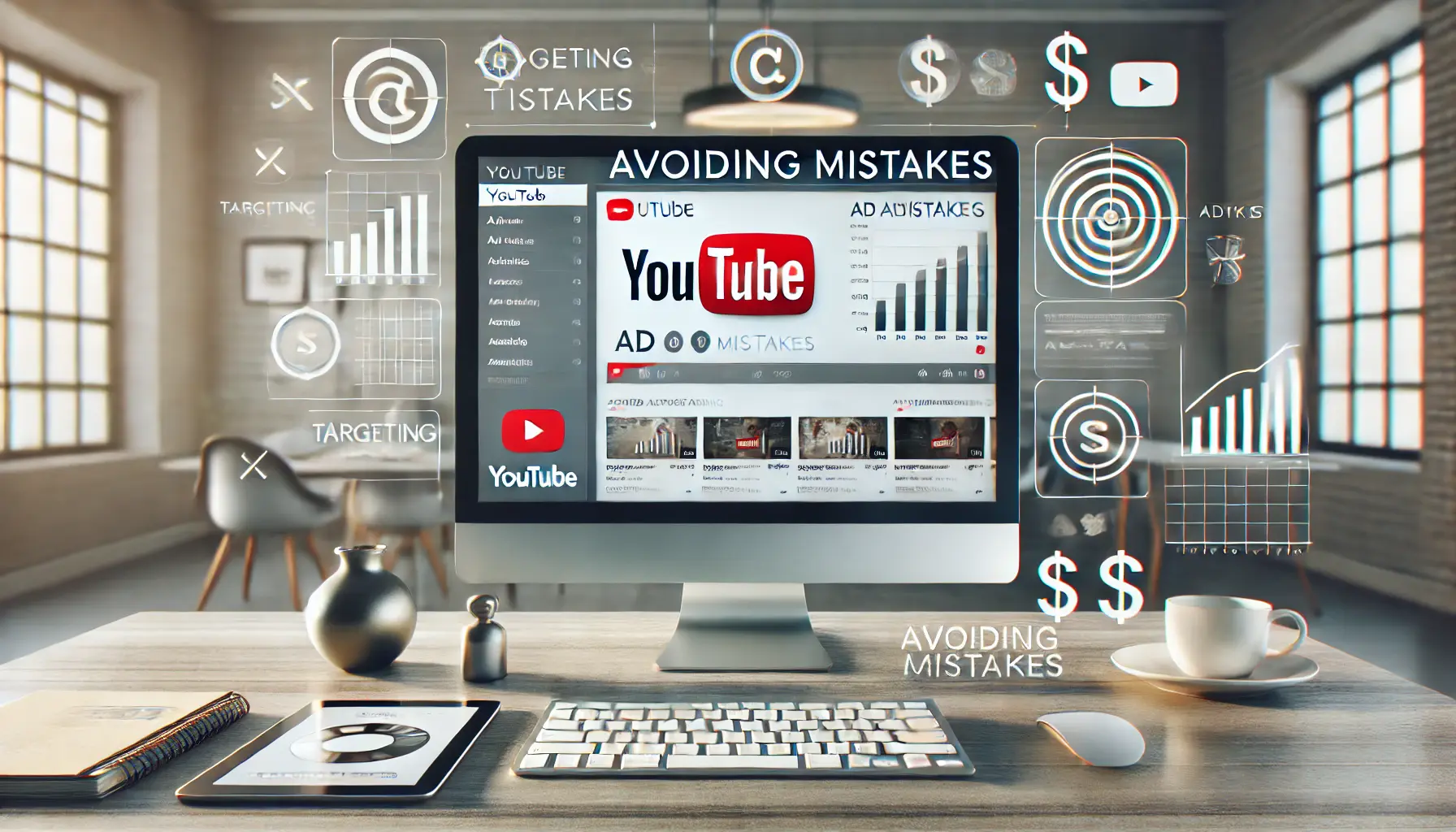In the fast-moving world of digital marketing, it is important to make sure that your ads on YouTube are relevant to your target audience.
But how do you know for sure that your ad content is really hitting the mark?
This is where A/B testingA method of comparing two versions of an ad to determine which performs better. comes in: the act of systematically comparing different versions of your ads to determine what really captures the interest of viewers and drives conversions.
Let’s delve into the importance of A/B testing in YouTube ads and explore effective strategies to optimize your video content and format.
- Understanding the Importance of A/B Testing in YouTube Ads
- Approach 1: Optimizing Video Content and Format
- Approach 2: Refining Targeting and Audience Segmentation
- Approach 3: Experimenting with Ad Placements and Formats
- Approach 4: Enhancing Call-to-Action (CTA) and Messaging
- Approach 5: Leveraging Analytics for Continuous Improvement
- Mastering YouTube Ad Campaigns with A/B Testing
- Frequently Asked Questions About A/B Testing for YouTube Ads
Understanding the Importance of A/B Testing in YouTube Ads
A/B testing, also referred to as split testing, is a process whereby two different versions of an ad, labeled A and B, are made to see which works best.
This is a method that will let you test creative visuals, messaging, and calls-to-action to see what really speaks to your audience.
By introducing A/B testing into your YouTube ad campaigns, you’ll be able to:
- Improve Viewer Engagement: Determine what ad elements attract the most attention and incite interaction.
- Improve Conversion Rates: Determine the most effective components that lead to desired actions, such as clicks or purchases.
- Optimize Return on Investment (ROI): Allocate resources to high-performing ad variations, ensuring efficient use of your advertising budget.
By leveraging A/B testing, you can make data-driven decisions that refine your advertising strategies, ultimately leading to more successful campaigns.
A/B testing is essential for making data-driven decisions in YouTube ad campaigns, ensuring improved engagement, conversion rates, and ROIReturn on Investment; a measure of the profitability of an advertising campaign.. Leverage this method to refine your creative strategies effectively.

An illustration of techniques for optimizing video content and format on YouTube.
Approach 1: Optimizing Video Content and Format
The content and format of your video ads play a pivotal role in capturing and retaining viewer attention.
To optimize these elements through A/B testing, consider the following strategies:

Illustrating the testing of different video lengths for YouTube ads.
Testing Different Video Lengths
Does your audience prefer concise messages or more detailed narratives?
Experiment with varying video lengths to find the sweet spot for engagement.
For instance, test a 15-second ad against a 30-second version to see which maintains viewer interest and drives action.

A comparison between live-action and animated content in YouTube ads.
Comparing Live-Action Versus Animated Content
The style of your ad can affect viewer perception.
Create one live-action version and another animated version.
Compare which will better communicate your message and speak to your target demographic.

A comparison of emotional and humorous storytelling approaches for YouTube ads.
Assessing Storytelling Methods
Storytelling in ads is one of the most effective methods.
Try some different methods, such as:
- Emotional Storytelling: Ads that use emotion to connect with users.
- Humorous Content: Light-hearted ads that entertain while delivering the message.
- Informative Segments: Educational content that provides value to the viewer.
Assess which storytelling technique aligns with your brand and resonates with your audience.
Keep in mind that A/B testing is performed with the sole intent of gaining actionable insights.
Key performance indicators include the duration of views, click-through rates, and conversion rates, which will give a fair idea of which variation works and which doesn’t.
Continuously refining your video content and format with data will help you maximize the effectiveness of your YouTube ad campaigns.
Testing video lengths, styles, and storytelling methods is crucial for understanding audience preferences. Regularly optimize these elements to create compelling and effective video ads.
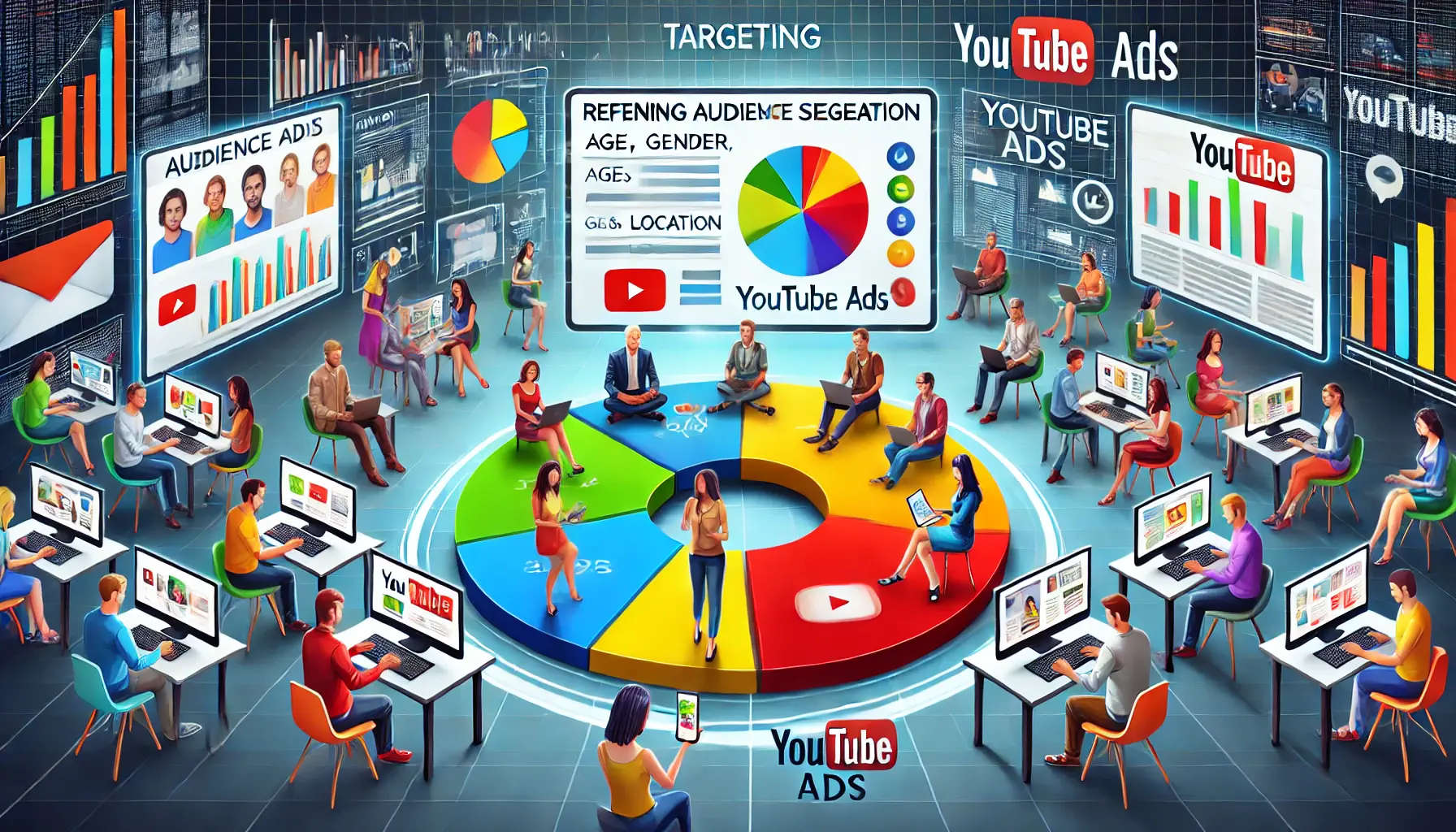
Illustrating the process of refining targeting and audience segmentation for YouTube ads.
Approach 2: Refining Targeting and Audience Segmentation
Ensuring your YouTube ads reach the right audience is crucial for maximizing engagement and conversions.
A/B testing plays a pivotal role in fine-tuning your targeting strategies.
By experimenting with different audience segments, you can identify which groups respond most favorably to your ads, allowing for more efficient allocation of your advertising budget.

Illustrating the process of identifying key audience demographics for YouTube ads.
Identifying Key Audience Demographics
Start by segmenting your audience based on demographics such as age, gender, location, and language.
For instance, you might test the same ad with two different age groups to see which one engages more effectively.
This approach helps in tailoring your content to meet the specific preferences of each demographic segment.
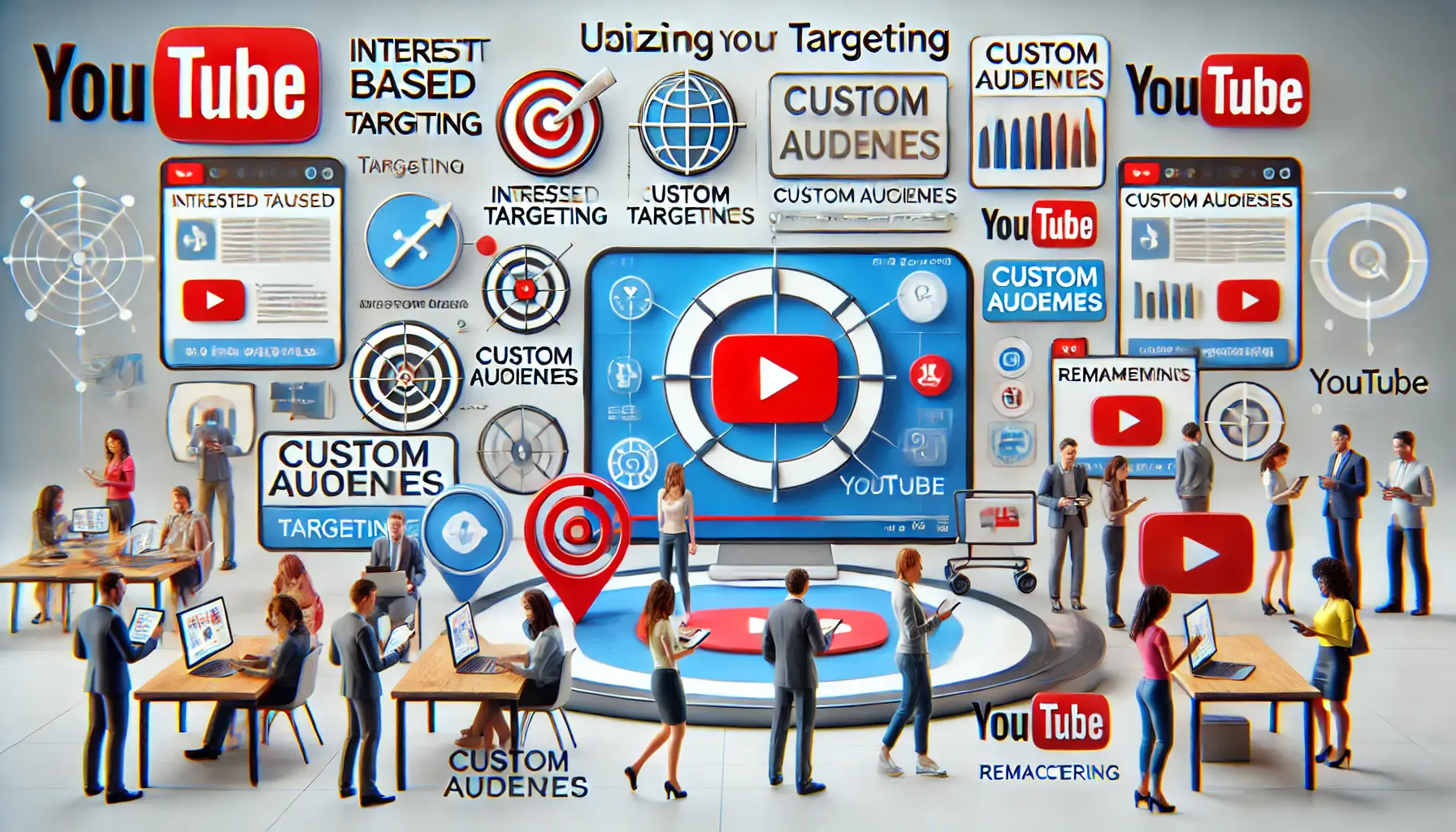
Illustrating the use of YouTube’s targeting features for digital marketing.
Utilizing YouTube’s Targeting Features
YouTube offers a variety of targeting options, including:
- Interest-Based Targeting: Reach users based on their interests and online behaviors.
- Custom Audiences: Upload your own customer data to target specific user groups.
- Remarketing: Re-engage users who have previously interacted with your content.
By leveraging these features, you can create more personalized ad experiences that resonate with your intended audience.
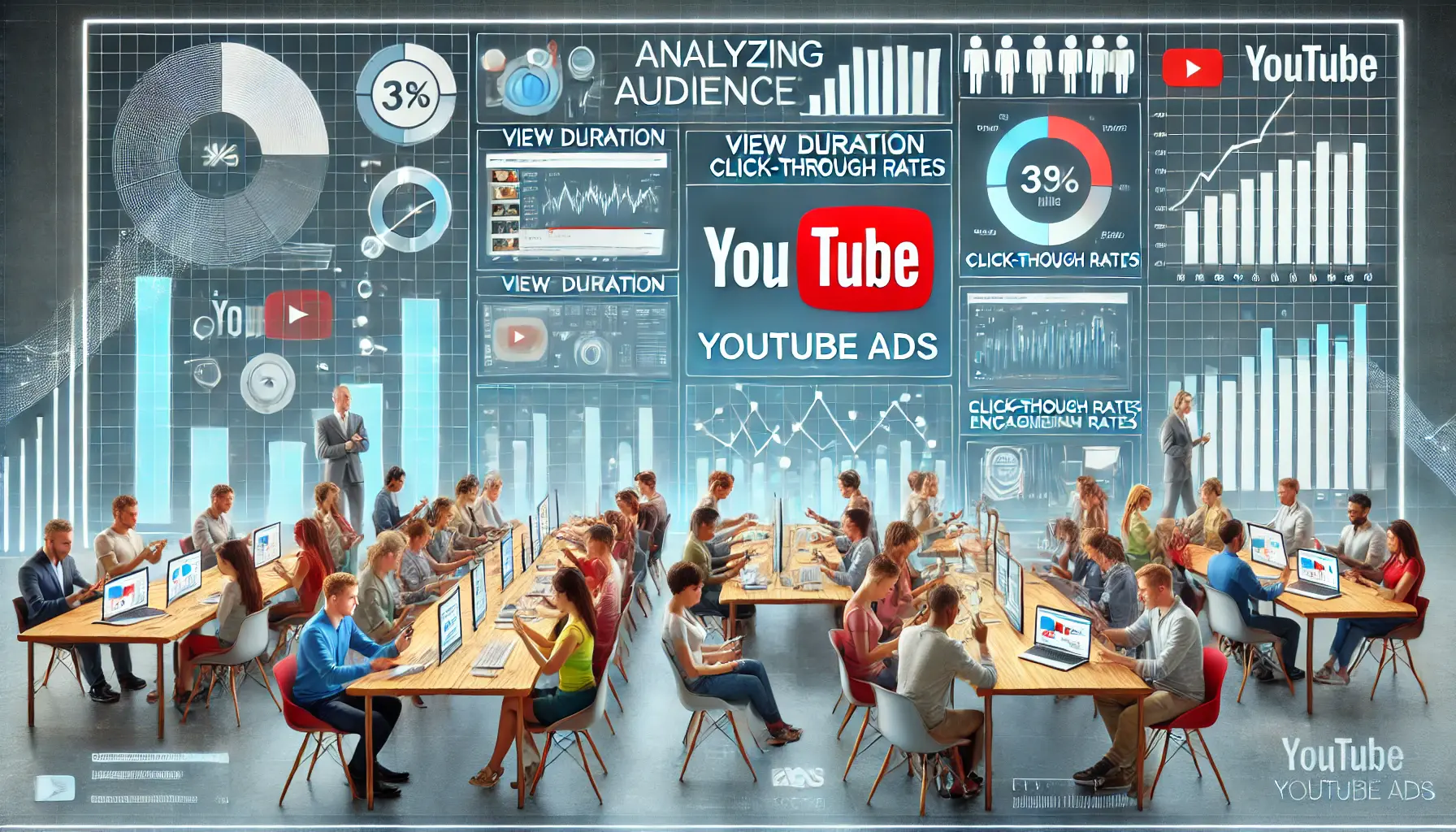
Illustrating the analysis of audience behavior and preferences in YouTube ads.
Analyzing Audience Behavior and Preferences
Dive into analytics that show how various segments have interacted with your ads.
Pay attention to metrics including:
- View Duration: The amount of time viewers are sticking around and watching your ad.
- Click-Through Rates (CTR): The percentage of people who clicked through to your website or landing page after viewing the ad.
- Conversion Rates: The number of people who took the intended action (e.g., filled out a form, ordered a product) after clicking on your ad.
These insights help you iterate on your targeting to ensure that your ads are only shown to the most receptive audiences.
Systematic application of A/B testing in targeting and audience segmentation efforts can drive better relevance and effectiveness in YouTube ad campaigns, thereby improving engagement and leading to higher conversion rates.
Segment your audience based on demographics and behavior. Use YouTube’s targeting tools to fine-tune your campaigns, ensuring your ads reach the right viewers.
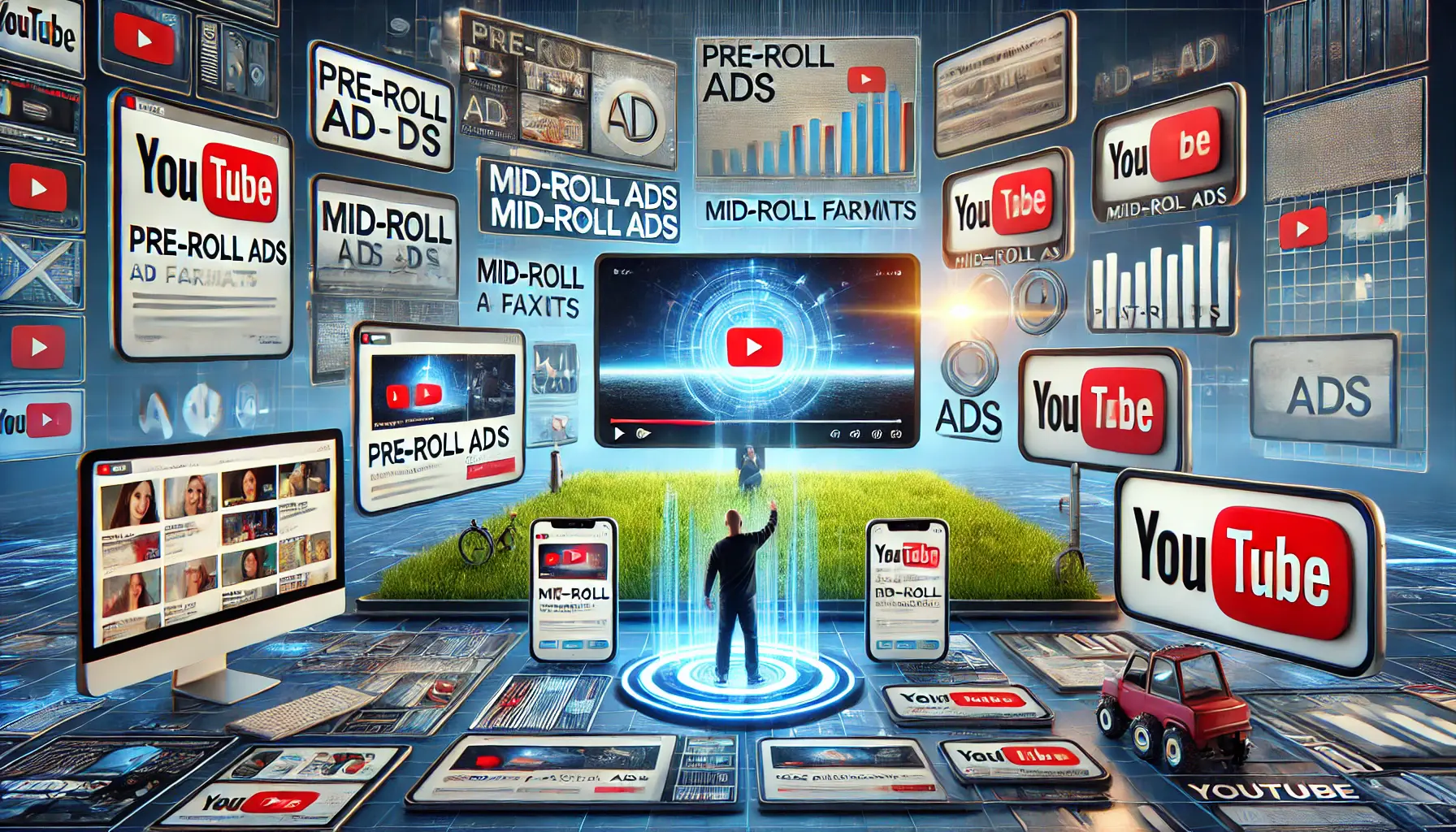
Illustrating the experimentation with ad placements and formats for YouTube ads.
Approach 3: Experimenting with Ad Placements and Formats
Optimizing your YouTube ad campaigns involves not only crafting compelling content but also strategically selecting ad placements and formats.
A/B testing serves as a vital tool in this process, enabling you to determine which combinations yield the highest engagement and conversion rates.
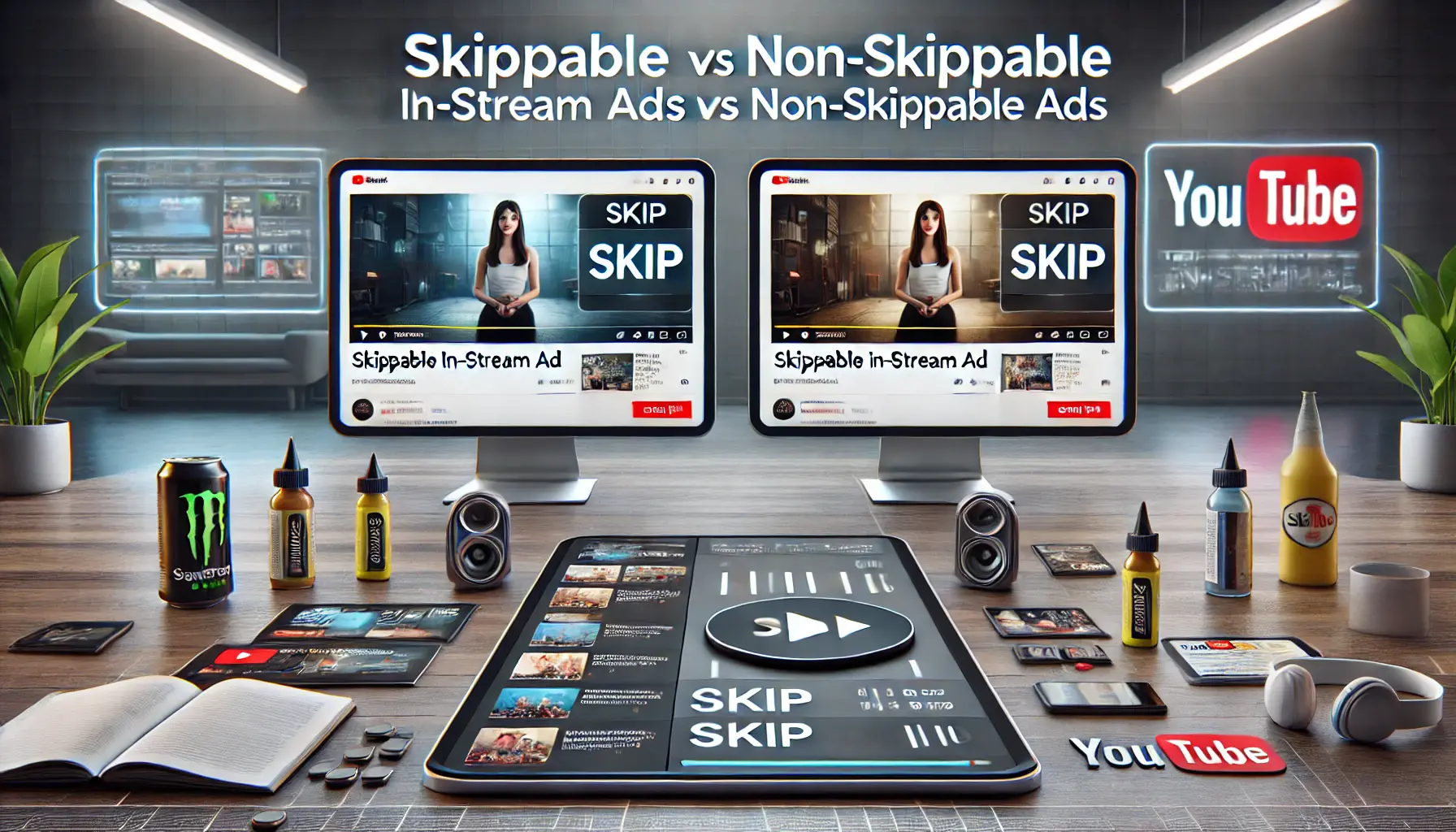
Comparing skippable and non-skippable ads in YouTube video players.
Assessing Skippable Versus Non-Skippable Ads
YouTube offers various ad formats, each with distinct viewer experiences:
- Skippable In-Stream Ads: The ad can be skipped after 5 seconds, giving viewers flexibility but potentially resulting in lower message retention.
- Non-Skippable In-Stream Ads: The ad needs to be viewed until the end, ensuring full message delivery but possibly frustrating viewers.
A/B testing between these two ad formats will help you identify which one best fits your campaign objectives and audience preferences.

Illustrating the strategic placement of YouTube ads at different times during a video.
Determining Optimal Ad Placement Timing
The timing of your ad’s appearance within a video can significantly impact viewer engagement:
- Pre-Roll Ads: Displayed before the main video content begins.
- Mid-Roll Ads: Inserted during the video, often in natural breaks.
- Post-Roll Ads: Shown after the video concludes.
A/B testing these placements helps determine when your audience is most receptive, allowing for strategic ad positioning that enhances viewer interaction.
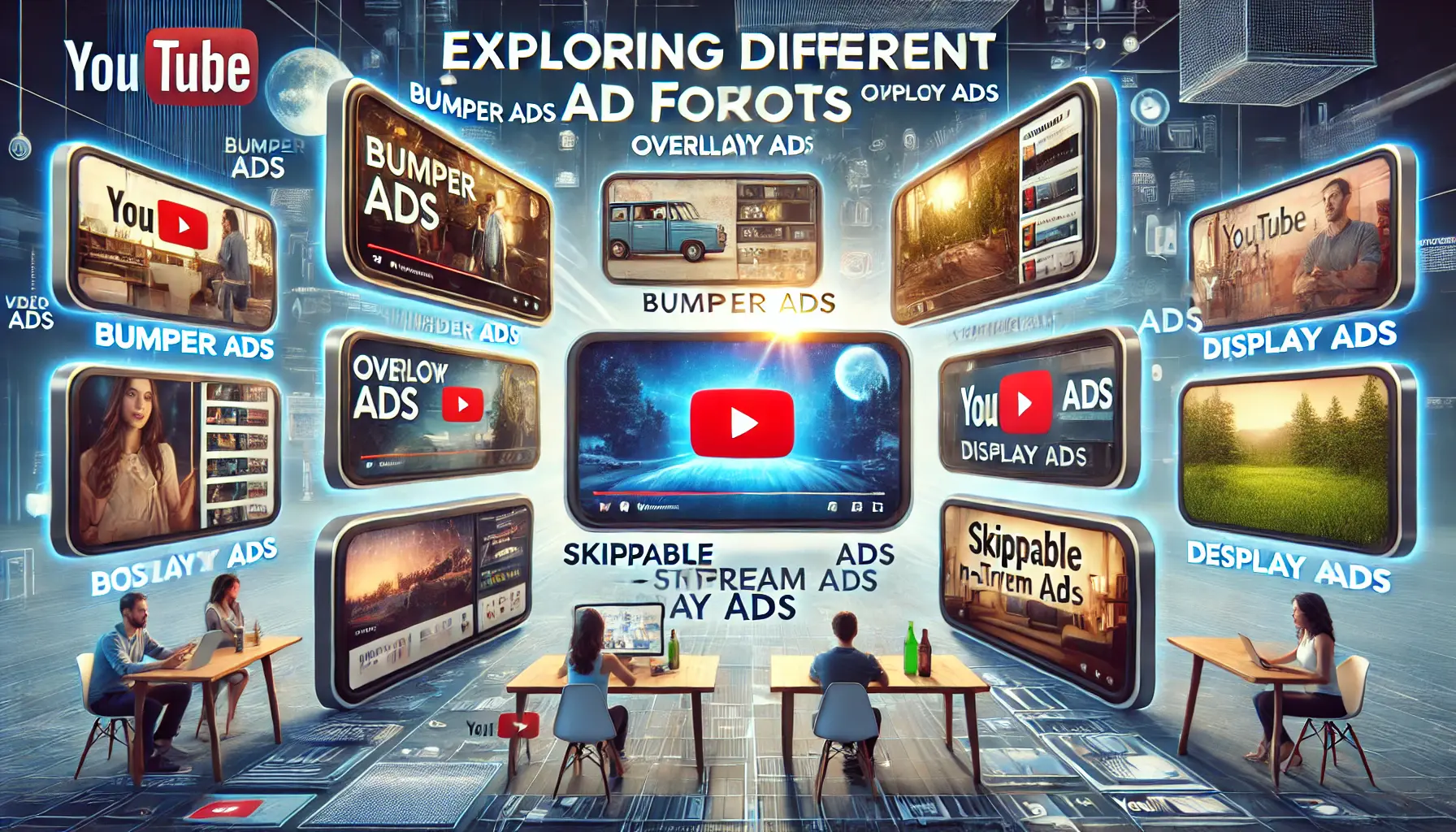
Illustrating various YouTube ad formats and their impact on user engagement.
Exploring Different Ad Formats and Their Impact
Beyond skippable and non-skippable ads, YouTube offers the following additional formats:
- Bumper Ads: Non-skippable ads up to 6 seconds in length, perfect for concise messaging.
- Overlay Ads: Semi-transparent ads that appear on the lower portion of the video.
- Display Ads: Ads that appear next to the video player.
A/B testing these formats enables you to assess their effectiveness in achieving your objectives, whether it be brand awareness or direct response.
By systematically testing various placements and ad formats, you can create an effective YouTube advertising campaign that ensures maximum engagement with your target audience and drives conversions.
Choosing the right ad placements and formats can drastically impact engagement. Use A/B testing to find the optimal combinations that align with your campaign goals.
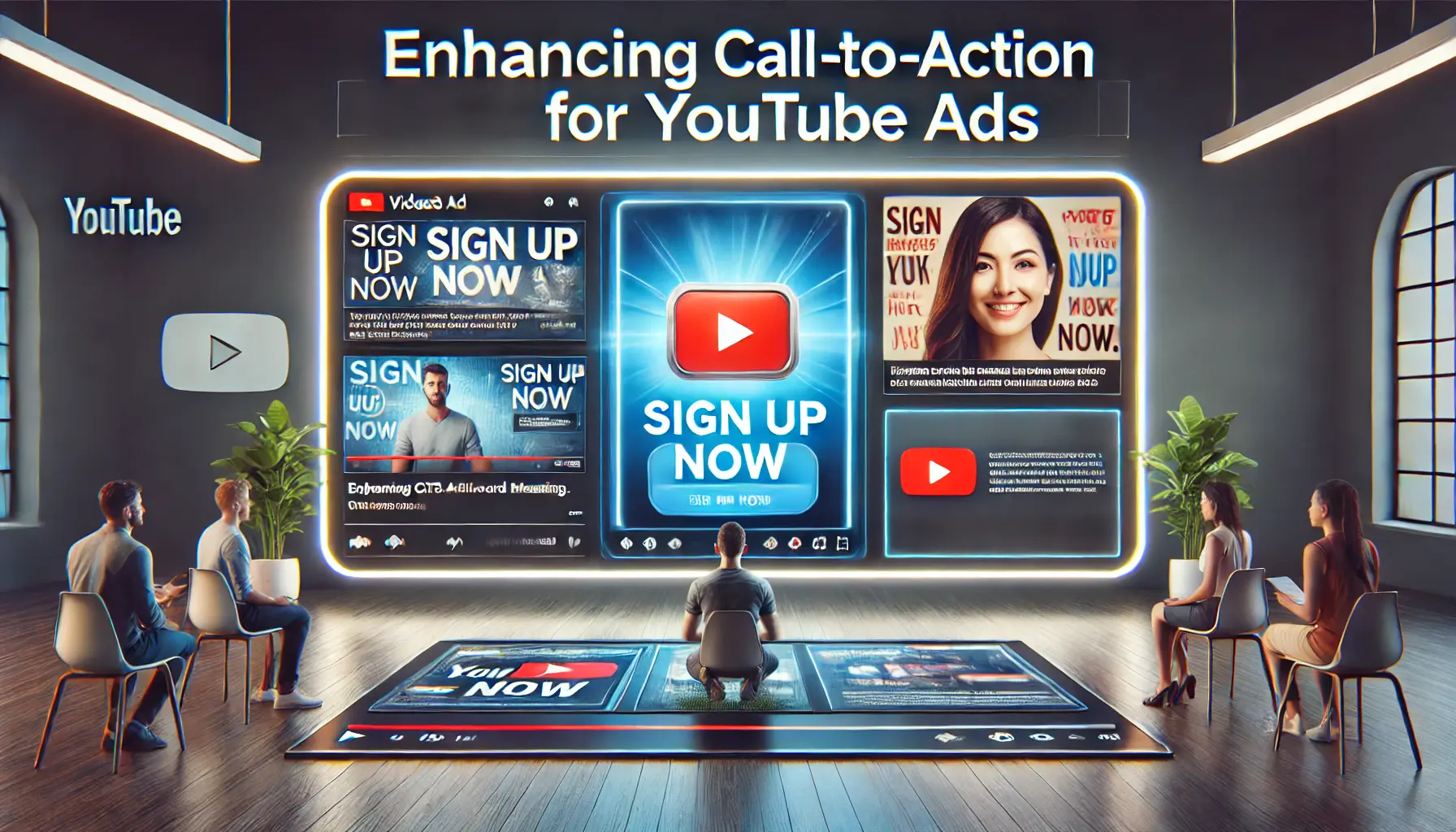
Illustrating the importance of CTA and messaging in YouTube ad effectiveness.
Approach 4: Enhancing Call-to-Action (CTA) and Messaging
In the realm of YouTube advertising, the Call-to-Action (CTA) serves as the pivotal bridge between viewer engagement and the desired outcome.
Crafting compelling CTAs and aligning them seamlessly with your ad’s messaging can significantly boost conversion rates.
Implementing A/B testing allows you to discern which CTAs and messaging strategies resonate most with your audience, thereby optimizing your campaigns for maximum impact.

undefined
Testing Various CTA Phrases and Designs
Experiment with different CTA phrases and designs to find out what prompts will urge your audience to take action.
Consider testing models like:
- CTA Phrases: Test directives such as “Learn More,” “Sign Up Now,” or “Get Started Today” to uncover which yields a stronger reaction from your audience.
- Button Designs: Change the color, size, and placement to find the most eye-catching combination for CTA buttons.
By systematically testing these elements, you will be able to determine which CTAs are most effective in driving viewers to take action.

Illustrating how different messaging strategies align with audience motivations in YouTube ads.
Aligning Messaging with Audience Motivations
Your ad should align with the motivations and needs of your target audience.
A/B testing different messaging approaches can help you find the most compelling narrative.
For example:
- Value Proposition Emphasis: Highlight the benefits or unique selling points of your product or service.
- Emotional Appeal: Craft messages that evoke emotions such as happiness, trust, or urgency.
Testing these approaches enables you to tailor your messaging to what truly resonates with your audience, enhancing engagement and conversion rates.

Illustrating the use of interactive elements like YouTube cards and end screens in ads.
Utilizing Interactive Elements
You can activate YouTube cardsInteractive elements that can be added to YouTube videos, encouraging user engagement. and end screensInteractive elements at the end of YouTube videos, prompting actions such as subscribing or visiting a website. to keep viewers interacting with your video.
These features add interactive, clickable CTAs that drive viewers to take actions such as visiting a website or subscribing to a channel.
A/B test the presence and design of these elements to determine their effectiveness in encouraging user engagement.
By investing in the optimization of your CTAs and messaging through A/B testing, you’ll be able to build YouTube ads that capture attention and drive viewers to take meaningful actions, helping you accomplish your marketing objectives.
Crafting clear, engaging CTAs and aligning them with audience motivations is key. Test various phrases and designs to boost conversion rates effectively.

Illustrating the use of analytics to improve YouTube ads through continuous data-driven optimization.
Approach 5: Leveraging Analytics for Continuous Improvement
To maximize the effectiveness of your YouTube ad campaigns, it’s essential to harness analytics for ongoing optimization.
A/B testing provides valuable data, but interpreting this information correctly is crucial for making informed decisions that enhance your advertising strategy.

Illustrating the use of YouTube’s analytical tools for optimizing ad performance.
Utilizing YouTube’s Analytical Tools
YouTube offers robust analytics tools that deliver comprehensive insights into your ad performance.
Key metrics to monitor include:
- Watch Time: The total time viewers spend watching your ads, indicating engagement levels.
- Click-Through Rate (CTR): The percentage of viewers who click on your ad after viewing it, reflecting its effectiveness in prompting action.
- Audience Demographics: Data on viewer age, gender, location, and interests, helping tailor your content to your target audience.
Regularly analyzing these metrics enables you to identify trends and areas for improvement in your ad campaigns.

Illustrating the use of third-party A/B testing tools to optimize YouTube ads.
Implementing Third-Party A/B Testing Tools
Beyond YouTube’s native analytics, third-party tools can enhance your A/B testing capabilities.
Platforms like TubeBuddyA third-party tool that enhances YouTube analytics and supports A/B testing. and Thumbnail Test allow for testing various ad elements, such as thumbnails and titles, providing deeper insights into viewer preferences.
These tools can help you refine your ad content to better resonate with your audience.

Illustrating the process of interpreting A/B test results to optimize YouTube ads.
Interpreting A/B Test Results
Understanding the results of your A/B tests is crucial to effective optimization.
Focus on statistical significance to ensure that observed differences between ad variations are not due to chance.
Key considerations include:
- Sample Size: Ensure you gather enough views to make reliable conclusions.
- Confidence Levels: High confidence levels, typically 95%, validate the reliability of your results.
By carefully interpreting these factors, you can make informed decisions to improve your ad performance.
Incorporating analytics into your A/B testing strategy fosters a culture of continuous improvement.
By systematically analyzing data and acting on insights, you can refine YouTube ad campaigns for better engagement and higher conversion rates.
With all five approaches elaborated on, the article concludes here.
Each section discussed how A/B testing can help in the comprehensive optimization of your YouTube ad campaigns, covering areas from targeting and creation to analytics and actionable improvements.
If you would like further additions on specific areas or new topics, please let me know, and I will be happy to assist you!
Utilize YouTube’s analytical tools and third-party platforms to interpret A/B test results. Regular analysis ensures your campaigns evolve based on actionable insights.
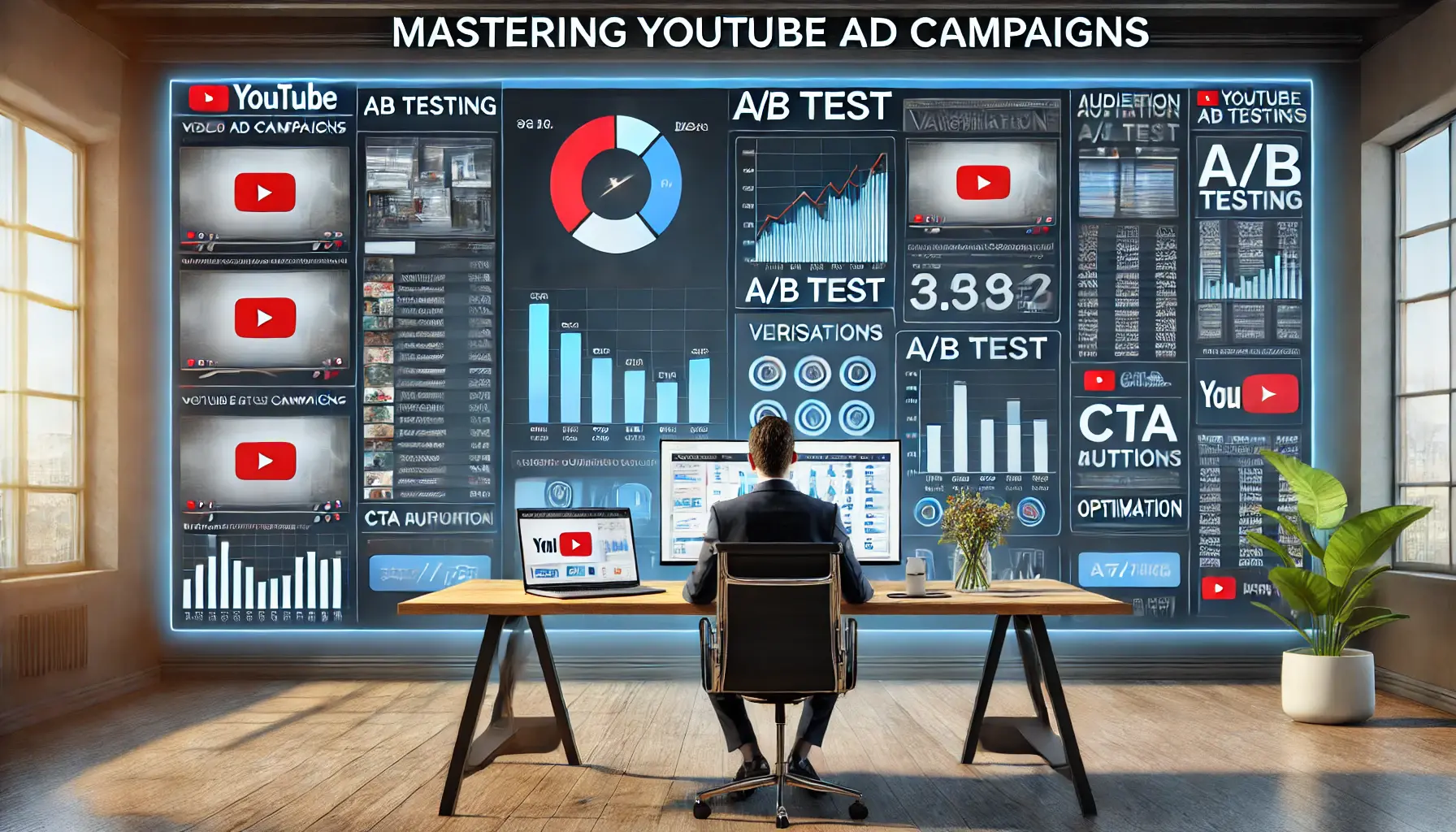
Illustrating the process of mastering YouTube ad campaigns using A/B testing and data analysis.
Mastering YouTube Ad Campaigns with A/B Testing
Optimizing YouTube ad campaigns requires a strategic approach, and A/B testing stands out as a powerful method to achieve this.
From refining audience targeting to analyzing the impact of creative content, A/B testing empowers marketers to make data-driven decisions that elevate campaign performance.

Illustrating the impact of A/B testing across multiple YouTube ad campaigns.
The Power of A/B Testing Across Campaigns
This article highlighted five important ways of A/B testing for YouTube ads, with actionable takeaways at each step:
- Optimization of Video Content and Format: Testing different video lengths, styles, and methods of storytelling ensures your content resonates with viewers.
- Refining Targeting and Audience Segmentation: Precise audience analysis helps identify key demographics and behaviors that align with your campaign goals.
- Testing of Ad Creative and Placement Type: Determining the best ad types and placement options maximizes viewer engagement.
- Enhancing Call-to-Action and Messaging: Creating calls-to-action that complement audience motivations increases the conversion rate and drives meaningful actions.
- Leveraging Analytics for Continuous Improvement: Data interpretation through advanced analytics provides insights into trends and aids in implementing ongoing campaign optimizations.

Illustrating the process of building a culture of continuous improvement in YouTube ad campaigns through collaboration and data analysis.
Building a Culture of Continuous Improvement
The success of YouTube advertising lies in the consistent application of A/B testing insights.
By embracing a culture of continuous improvement, marketers can adapt to changing audience preferences, enhance engagement, and achieve better ROI.
Each test offers a learning opportunity that contributes to long-term campaign success.

Illustrating the process of taking the next step in YouTube ad optimization through data analysis and strategic decision-making.
Take the Next Step
Now that you understand the importance of A/B testing for YouTube ad optimization, it’s time to put these strategies into practice.
Begin by assessing your current campaigns, determining areas for improvement, and implementing targeted tests.
By making data-driven decisions, you can ensure your campaigns remain effective and competitive in today’s dynamic digital landscape.
Mastering A/B testing in YouTube ads isn’t just about improving individual campaigns; it’s about building a sustainable strategy that delivers consistent results.
Let these insights guide you toward creating impactful ads that resonate with your audience and drive measurable success.
Continuous improvement through A/B testing not only enhances individual campaigns but also builds a sustainable, long-term strategy for digital success.
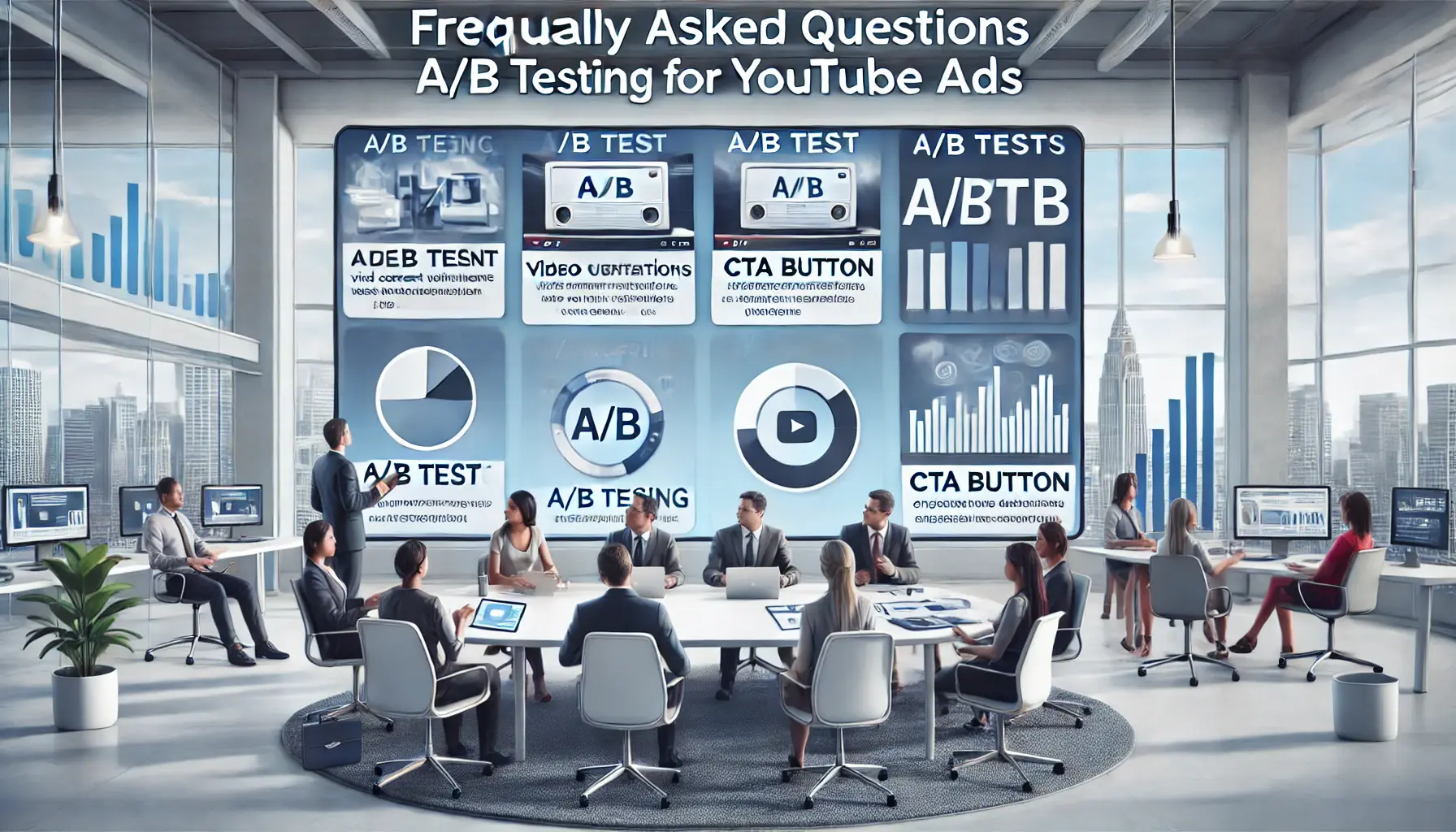
Illustrating a collaborative discussion about A/B testing for YouTube ads in a modern office setting.
Your campaigns can be managed by an agency specialized in Google Ads, check out our service page.
Frequently Asked Questions About A/B Testing for YouTube Ads
Delving into A/B testing for YouTube ads often brings up several common queries.
Here, we address these frequently asked questions to provide clearer insights into optimizing your YouTube advertising strategies.
A/B testing, or split testing, involves comparing two ad versions to determine which performs better.
This method helps identify effective elements in your YouTube ads, enhancing engagement and conversions.
A/B testing allows marketers to make data-driven decisions, optimizing ad performance by understanding what resonates with the audience, leading to improved engagement and higher return on investment.
Key elements to test include video content and format, targeting and audience segmentation, ad placements and formats, call-to-action (CTA) and messaging, and various creative aspects like thumbnails and titles.
Success is measured by analyzing metrics such as click-through rates, view duration, conversion rates, and overall engagement.
Statistical significance ensures that observed differences are not due to chance.
The duration depends on factors like audience size and engagement levels.
It’s essential to run tests long enough to gather sufficient data for reliable conclusions, often requiring several weeks.
While possible, testing multiple elements at once can complicate result interpretation.
It’s advisable to test one variable at a time to clearly understand its impact on ad performance.
Tools like YouTube’s Test and Compare Thumbnails and third-party platforms such as TubeBuddy offer features to facilitate A/B testing of various ad components.
By identifying and implementing the most effective ad elements, A/B testing enhances viewer engagement and conversion rates, leading to a more efficient allocation of your advertising budget.
Challenges include ensuring statistical significance, selecting appropriate variables to test, and accurately interpreting data to make informed decisions for campaign optimization.



